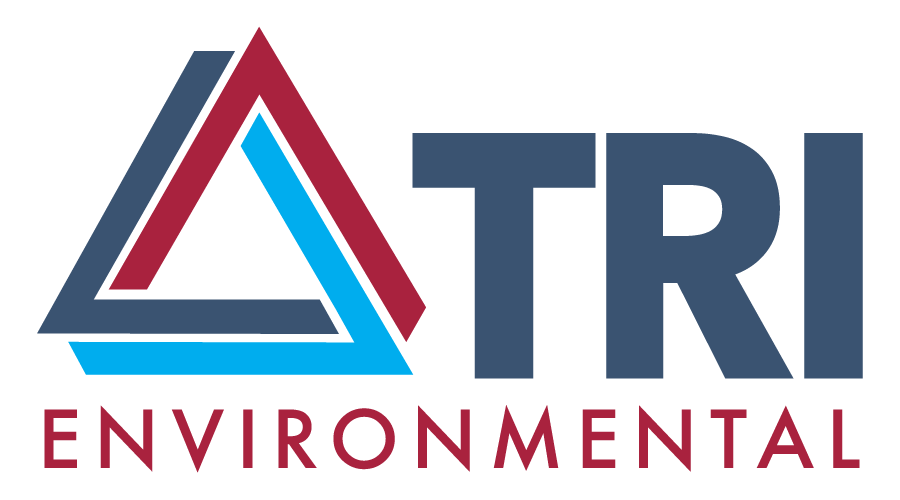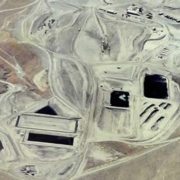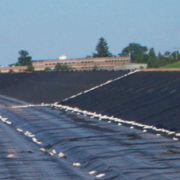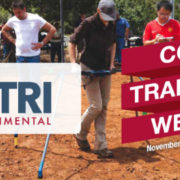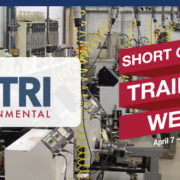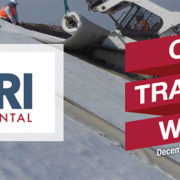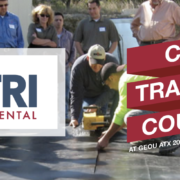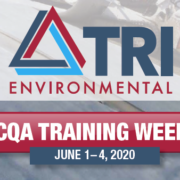TRI’s In-Plant Sampling Service: FAQs
TRI has provided geosynthetic in-plant sampling and sample management services for many years. Still, it’s an area of service that receives a lot of questions about what these programs entail and how they can best be used.
Sampling epitomizes how the field uses independent, third-party expertise. It is one of TRI’s primary services to the geosynthetics industry. Sampling verifies material qualification for job sites while helping keep production and construction/installation schedules moving forward.
High-quality sampling programs can substantially minimize project delays by streamlining the material qualification path between the factory and the independent lab.
Here are the most common questions TRI receives about in-plant sampling and sample management services.
How did In-Plant Sampling (IPS) begin?
When US EPA technical guidance was promulgated in the early 1990s, it included direction for independent confirmation of geosynthetic materials designated for a given site. Three-foot by roll width samples were to be cut from representative on-site product rolls and shipped to a qualified laboratory for conformance or confirmation testing. This approach was challenging when measured properties resulted in test results that failed to meet the project specification, as now product rolls already delivered to a site were suspect and resolution was needed in order to move forward in terms of additional re-sampling and re-testing. Or, failing rolls would need to be replaced, replacement rolls would need to be delivered, failing rolls would need to be re-allocated, etc. Along with this, robust project communication and negotiation was required, as all changes in the schedule and site supply came with cost implications as teams waited for roll resolution.
Thus, in-plant, independent, third-party geosynthetic sampling emerged. It initiated a new perspective, whereby samples were taken in the manufacturing plant as materials were produced and/or moved to inventory. In this new approach, product rolls could be sampled and tested concurrently with the manufacturer’s own quality control testing activities. Any issues, if realized, could be resolved before shipping occurred. The pre-shipment testing process was performed and results were reviewed before shipment. It was a much better sampling approach for all parties involved.
What does it mean when you "process" a sample?
Processing a given sample primarily refers to the reduction of a sample to save shipping costs while preserving the representativeness of the sample for testing integrity. A one meter (3 feet) by roll width sample is often called for in specifications. Indeed, this is what is typically secured from a production line or an inventoried product roll. However, after securing the required specimens for testing from the proper locations across the roll width, much if not most of this roll-width material is discarded.
To avoid this waste and save significant shipping costs, a sample is processed by securing coupons from across the roll width sample. These coupons are then stacked and taped and labeled with lot and roll number for shipping purposes. The laboratory then cuts test specimens from each of the provided coupons per test sample.
Is IPS really that independent from the manufacturer?
This is a very common question and occasionally an undeserved indictment of IPS. That said, it is a reasonable question, the roots of which are found in an approach to IPS that is no longer standard.
Many years ago, IPS involved a team of inspectors occupying the plant to observe production and secure samples 24 hours a day, 7 days a week during a project-specific production. As a production event could take many days, IPS would represent a relatively large part of the quality assurance sampling and testing budget.
Today, though full-time IPS is required for critical projects involving specialty materials, the vast majority of IPS involves part-time sampling. This service is usually based on a single or, at most, a couple of plant visits per day during manufacturing. The rationale for this is that while geosynthetic manufacturing is a process that demands carefully managed controls, the manufacturing procedures for most geosynthetics are well established and relatively straightforward to monitor and track. The “non-independent” part of sample collection, and the part of sample collection that some question the validity of, often involves manufacturing personnel contributing to collection of multiple sample rolls and/or securing a sample with associated unique identification marks. While this is NOT performed by the independent sampler, the process is validated by the independent sampler during each trip to the plant. In a single visit per day, an in-plant sampler can check production lists for each relevant production line, witness and inspect the manufacturer-collected samples, and verify that the production reports and listed roll numbers align with available samples. The independent IPS personnel will also go directly to the production line(s) and select an independently secured sample from production. Furthermore, they may review the manufacturing quality control (MQC) testing on-site to verify all rolls selected are being tested in the MQC lab. In this way, all samples are marked, validated, and secured as representative of a given production event.
How are samples collected?
There are several approaches to securing samples that combine the manufacturer and the independent sampler collection of roll samples. These include:
- The use of matching stickers – one for the collected sample and one for the product roll from which the sample is secured.
- The use of painted machine-direction lines on the sampling location. The sample is then cut from the production dividing the painted line approximately in half (one half remaining on the produced roll and the other half represented on the collected sample)
- The manufacturer may cut three different roll width samples per required frequency and the independent sampler may “independently” select any of the three collected.
Approaches (a) and (b) allow for on-site verification, as product rolls have sampling lines or stickers. Approach (c) can also be effective, as the choice of sample is given to the independent sampler. All these mechanisms are augmented by the independent sampler themselves when in the plant by selecting project samples directly from the production line(s) or inventory.
Are "cut-and-ship" policies part of independent, in-plant sampling?
The “cut and ship” policy implemented by some projects or manufacturers does NOT involve any level of independence. They default entirely to the manufacturer to collect samples per the required frequency and ship the samples to a lab. This has been defended on occasion by those who believe that part-time sampling is not 100% independent.
Ultimately, “cut and ship” practices completely undermine the USEPA CQA guidance. They weaken the entire notion of independent sampling in the field or in the manufacturing plant.
Independent sampling programs support not just individual projects and confidence in the quality of site materials but the entire geosynthetics industry’s quality protocols and trust.
The manufacturer will sometimes tell me that samples are available. How can that be if the sampling company has not even gone to the plant to sample yet?
An independent sampler might not be there at a given time associated with securing a sample, but samples may have been collected and have been set aside for the independent sampler to arrive, validate, and process. Samples may also be available from those held in established product inventories. Again, these samples are “available” but are waiting for the sampler to arrive.
Is there a consensus-based standard procedure for in-plant sampling activities?
Yes … and No. ASTM D4759, Standard Practice for Determining the Specification Conformance of Geosynthetics, provides language specific to the general practice of collecting samples on site or in the manufacturing plant. In this context it is appropriate to reference this standard when specifying in-plant sampling.
However, the standard does not describe the myriad of details associated with performing sampling at a given production facility (discussed later).
Why do you sometimes sample and test a roll that is subsequently not received on site?
This question is also received a lot in the rush of summer construction. Remember that the benefit of in-plant sampling is to accelerate the collection and independent verification of produced materials to avoid delays. Sometimes the collected samples fail to meet required criteria in the conformance verification lab and/or the manufacturer’s own MQC lab. In other cases, some produced rolls may be diverted from one project to another to meet manufacturer scheduling demands. Other reasons may include the inability to quickly locate the roll at time of shipment, the accidental gouging by a fork lift requiring it be cut back before being sold, or a label falling off or becoming illegible so a replacement roll is required. Another possibility is an inventory roll is “double sold.” A roll is manufactured for Job A, but inadvertently is sold to Job B. Many things can happen and do occasionally. When this is the case, those rolls are rejected for shipment to the original site and will most often be sold elsewhere. In the case of a test failure, replacement and/or bracketing rolls must be collected and tested and depending on the rush of schedule, sometimes these samples must be collected on the job site.
Can anyone go to a plant and sample produced materials?
Absolutely not! Manufacturers must grant permission. Each manufacturing facility is unique in its layout, safety protocols, and responding rules, training routines, access limits, and personnel decisions. When TRI samples in any plant, we are a guest at the facility and are obliged to follow all the plant’s governing rules. In addition, each facility differs in culture, footprint, and material handling protocols. These differences are learned and practiced with time and represent a considerable investment in accommodating site-specific rules while performing independent sampling and sample management work.
When a product roll arrives on site, how do I know that you’ve sampled it?
You should see sample stickers or lines associated with samples that have been collected and tested. Otherwise, you will not have a designation other than a conformance test report of the specific roll tested and included in your on-site inventory of received product rolls.
How do you collect component geotextiles or geonets when sampling a drainage geocomposite?
Great question! Because removal of already bonded geotextile materials from the core geonet is STRONGLY discouraged (due to inflicted geotextile damage during the removal process), component geotexiles and geonets are typically provided from the manufacturer with a production report associating geotexile rolls with their core geonets. The independent sampler always secures a fully bonded geocomposite sample directly from the production line if able and production is currently ongoing; but, this is completely reliant on the manufacturer if the independent sampler is sampling from inventory alone. Some have attempted to test the unbonded edges for geotextile properties but this is also suspect, especially if measured properties fail to meet specification, as the results are not reflective of the roll width. Still, one of the great benefits from sampling at the plant is the ability to secure the unbounded components when sampling geocomposites in order to verify both component materials as well as the final geosynthetic drainage product.
Why is sample shipment so expensive?
Agreed. It is expensive! In-plant sampling actually provides cost relief here. While TRI has no control over what shipping companies charge for their services, we do emphasize with our clients that by collecting and processing geosynthetic samples in the manufacturing plant, we significantly reduce the mass of collected samples necessary to ship and thereby reduce the cost for sample shipment. Although it is not always possible, it is also advantageous to plan for sample collection and shipment well before data and materials are needed on-site. In this way, samples do not need to be rushed overnight for immediate testing. Rush sample shipment adds a significant cost to the material verification testing program. GCL samples especially may be very expensive to ship unless maximum planning and more reasonable shipping schedules are realized.
How can we assist on making sure you are ready to collect samples for our job?
Smooth, efficient in-plant sampling begins with pre-manufacturing communication between the client, TRI, and the manufacturer. As soon as material is ordered, TRI should be notified by the client. This is very important when schedules are compressed, component sampling is required, and time-dependent tests are involved (e.g., friction, longer-term transmissivity, and/or stress crack resistance). TRI will have a few questions that will need to be addressed in order for us to establish the sampling program with the manufacturer. If information is not provided in a timely way, delays in production scheduling or sampling may result. Most manufacturers will NOT schedule any production until conformance requirements are fully defined.
Finally, direct communication to TRI regarding the chosen manufacturers is always appreciated. All too often, TRI’s first awareness of a sampling project comes from the manufacturer and not the client. When the client initiates the communication, and when all parties have a little more time to establish or anticipate the sampling needs, the process can be very efficient, save cost on shipping, and help prevent delays on site.
TRI welcomes your questions on in-plant sampling, testing procedures, and all other services we provide.
